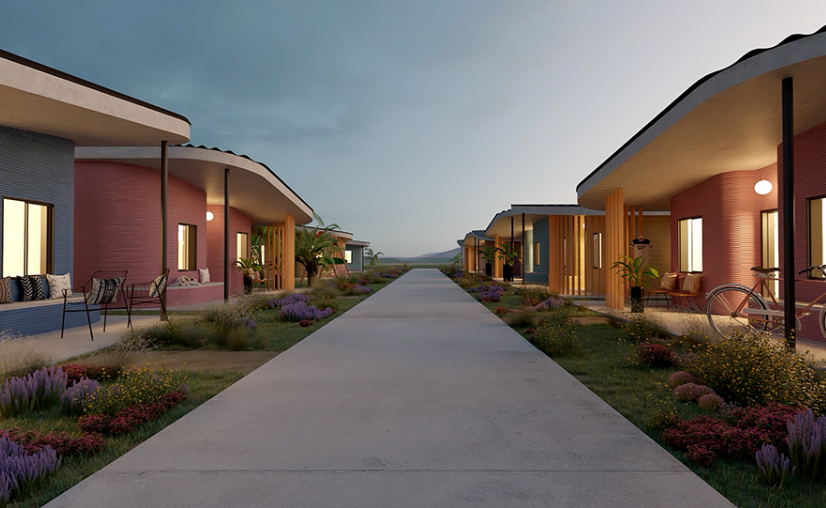Fuseproject, a design studio based in San Francisco, has revealed details regarding its collaborative project with New Story, a non-profit organization fighting homelessness, and ICON, a Texas-based construction technologies company, to 3D print houses in Latin America. Slated to be 3D printed in summer 2019, the organizations have worked together to design, plan, and build what is said to to be the “world’s first 3D printed community”. The project has been established to utilize 3D printing’s unique design possibilities to build homes for a low-income community in Latin America that adapts to their day-to-day lives.
“We are thrilled to partner with New Story on their mission to end global homelessness,” said Yves Béhar, founder of Fuseproject.
“I believe the most advanced technologies can deliver designed solutions for those most in need, and it is both the new technology from ICON and the vision of New Story that is making it possible today.”

Using 3D printing to fight homelessness
The project is spearheaded by New Story, an organization researching technological breakthroughs in home-building to tackle the global housing crisis, which has identified 3D printing as a viable solution to the issue. In 2018, New Story and its partner ICON were able to 3D print a house in Austin, Texas in 48 hours as a proof of concept, at a cost of less than $4000 using an early iteration of the Vulcan 3D printer from ICON.
Now, collaborating with Fuseproject, New Story will utilize the updated Vulcan 2 construction 3D printer to produce homes at an undisclosed location in Latin America, reportedly in as little as 24 hours and costing $6,000 for each building. The three organizations have worked closely with residents in Latin America to understand and learn about the culture and environment of their community. This is in order to ensure that the 3D printed residences respond to the community’s specific motives, habits, and needs beyond what traditional home design could do. Comprised of mostly farmers and artisans, the community contains homes with multi-generational families living closely together.
The findings of the community brainstorming process, involving on-the-ground workshops, suggested that New Story, Fuseproject and ICON needed to use 3D design to create housing that addressed “climate, family structure and the role that the homes play in creating a larger community.” Béhar explains further: “As we spoke to the community members, we realised that a single house design doesn’t respond to the needs and expectations.”
“This led us to design a system that allows for different programmes, climate factors, and growth for families and spaces.”

Working with the community to design adaptable 3D printed homes
Each of the 3D printed houses will cover a space of 120 m², with the interior space of the homes measuring around 55 m². Their outdoor designs incorporate spaces for cooking and eating, with a roof overhang extending to the front and back for shade from the sun, as well as protection from rainfall, adapting to the tropical environment. Due to the local environmental conditions of climate and seismic activity as well, the 3D printed homes have also been fitted with technological and design enhancements to the base structure, featuring additional reinforcement in the wall cavities.
3D printing has been used within the homes to enable built-in elements such as kitchen and bathroom counters, seating, shelves and ledges in the walls and embedded structural hooks for building further home storage and cupboards. Windows and door openings have been strategically placed alongside an open floor plan in the 3D design allowing for improved air flow. ICON’s 3D printing technology also allowed for the creation of curved walls with built in details without additional costs, as well as customizable choices to allow for the personalization of the homes. This enables families to feel a sense of ownership over their home, as well as creating a set of diverse buildings within the 3D printed community.
Developing the future of 3D printed homes
The 3D printing of homes potentially allows for the manufacturing of housing at a faster rate than traditional methods, which is said to take up to 3 weeks, with less costs and material wastage as well. These factors enable it to provide a possible solution to homelessness and inadequate housing, as well as a sustainable method of construction, and therefore increased efforts have been placed to develop the process.
For example, ICON had previously raised $9 million in seed funding in order to support its endeavours alongside New Story and Fuseproject to reinvent the construction of affordable homes with the use of 3D printers. Taking place in 2018, it was said to be one of the largest seed rounds for Texas startups that year.
Organizations using 3D printing to create sustainable housing includes Suncomy, a U.S. construction company. It received permits in early 2019 to build its first 3D printed geopolymer additively manufactured house in Lago Vista, Texas.
Furthermore, Graz University of Technology (TU Graz) has been working on a project investigating the development of 3D printed concrete parts for construction. The aim is to eventually implement the technology into buildings and houses.
You can now cast your vote for the third annual 3D Printing Industry Awards. Help decide this year’s winners now.
Subscribe to the 3D Printing Industry newsletter for the latest news in additive manufacturing. You can also keep connected by following us on Twitter and liking us on Facebook.
Looking for a career in additive manufacturing? Visit 3D Printing Jobs for a selection of roles in the industry.
Featured image shows a rendering of the 3D printed community, Image via Fuseproject.


